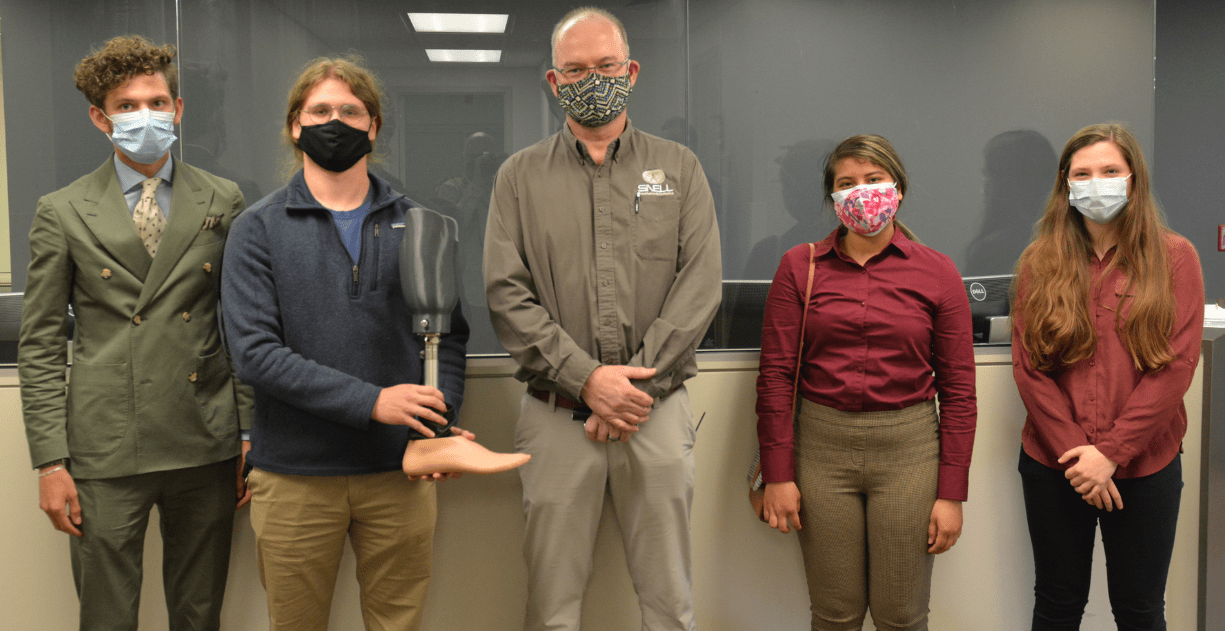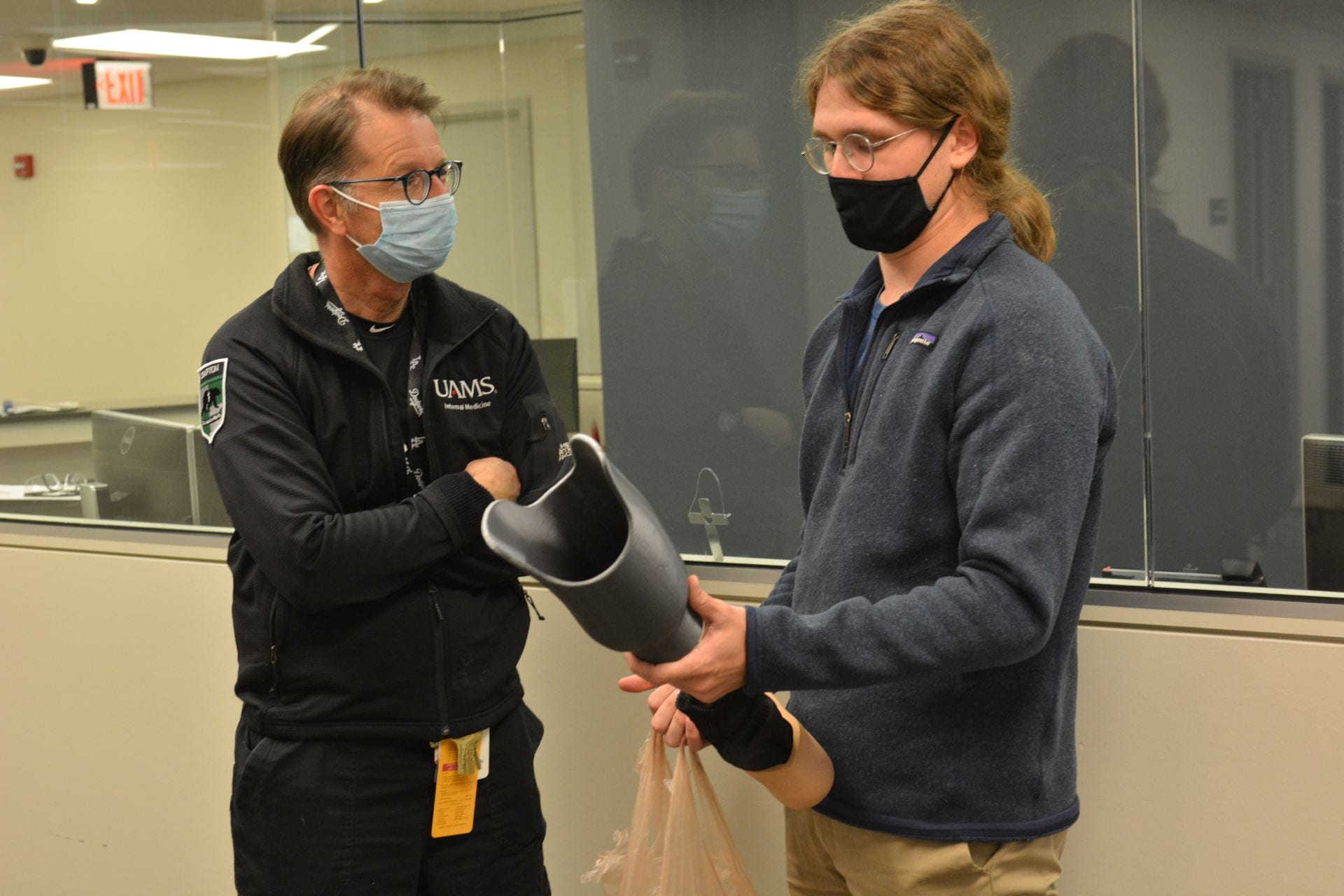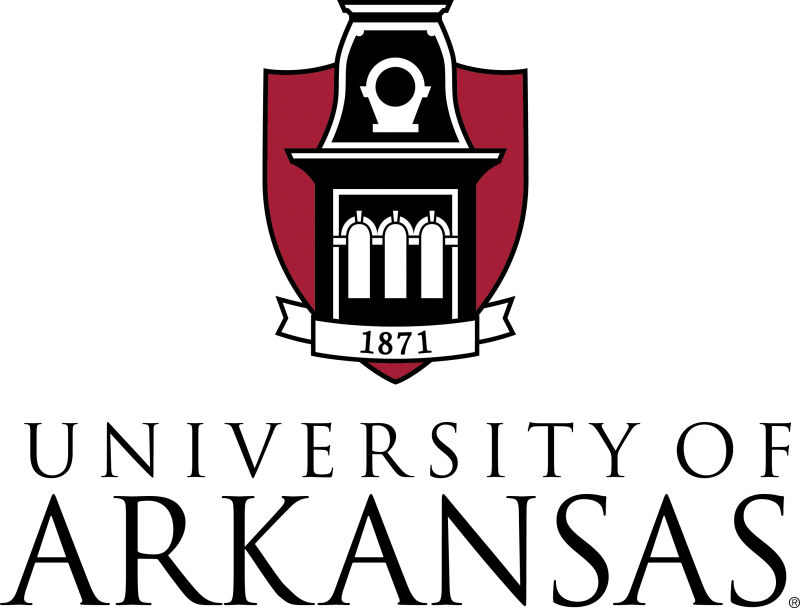Man Walks Again Using Free Prosthesis UA Students Developed as Senior Project

When Benson Laikidrik lost the lower part of his right leg due to complications from diabetes, he didn’t have much hope that his quality of life would ever be the same.
But thanks to a collaborative effort by the University of Arkansas College of Engineering, University of Arkansas for Medical Sciences in Northwest Arkansas and Snell Prosthetics & Orthotics in Fayetteville, Laikidrik has a custom-designed prosthesis that has given him back the mobility to do things he thought he could never do again.
Laikidrik originally came to the UAMS North Street Marshallese Clinic in Fayetteville for consultation and treatment of his diabetes. It was too late to save his leg, so it had to be amputated below the knee. He didn’t have insurance, and the cost of a prosthesis was more than he could afford.

The clinicians at the UAMS clinic started talking about how to help him.
“We all just thought, ‘Gosh, wouldn’t it be great if he could get a prosthesis and walk again,’” said Tom Schulz, M.D., director of the clinic and the UAMS internal medicine residency program.
Schulz checked with the UA Biomedical Engineering department, which has long had a collaborative relationship with UAMS. Assistant professor Mostafa Elsaadany, Ph.D., and associate professor Morten Jensen, Ph.D., presented the idea as a project option to one of the biomedical engineering senior design groups. The group loved the challenge of the project and the prospect of helping someone walk again.
The student team consisted of Seth Box, Kyle Potts, Nathalie Cedeno, Reagan Dugan, Alexandria Paton and Zachary Williams. They knew they wanted to make a prosthesis, but they had limited resources in the lab and a limited budget. So they started looking at patented prosthetic designs for transtibial prosthetics.
“Out of all the research and brainstorming, the idea that came to the forefront was taking a used prosthesis and doing what we could do to make it fit him,” Box said. “The best way we found to do that was to make a socket, which is the most custom-fitted piece of a prosthesis.”

Because they had a 3D printer in the lab, they started thinking about how to use that technology to create a cost-effective alternative to traditional sockets, which are made of expensive materials like carbon fiber and fiberglass.
“No matter what, we were going to get Mr. Laikidrik a free device,” Box said. “That was a goal that we took on.”
Although they had a cost-effective solution for the socket, everything else needed for the prosthetic was way above their budget. Enter Snell Prosthetics & Orthotics, which donated the prosthesis that attaches to the custom socket the students built.
Greg Johnson, a Snell prosthetist and orthotist, provided the students hands-on assistance in making a mold of the patient’s residual limb. He also offered to provide advice as the students made the 3D printed socket for Laikidrik.
“Snell, and Mr. Johnson in particular, came through for us big time,” Box said. “They were extremely generous.”
The students met with Laikidrik about two months before the first fitting to take some measurements. At a second meeting with Laikidrik, the students took a cast mold of his residual limb. Then they scanned the mold and used a 3D model of the scan to make the socket using the 3D printer.
On the day of the first fitting of the prosthesis with Laikidrik, the students excitedly showed off the fully assembled prosthesis. They also demonstrated the state-of-the art functionality of the hydraulic ankle, which flexes and bends when pressure and weight is applied.
“The fitting was the most rewarding part of the process,” Box said. “It doesn’t get any better than that. He was able to put it on and just start walking around. To give back that mobility to the patient is very fulfilling.”
The UA professors praised the students’ efforts and also thanked UAMS for bringing them the project.
“Working with our clinical partners and industry on a project that directly benefits the community is a perfect example of the ‘real-life’ biomedical engineering experience we try to give our senior design students,” Jensen said.
It was a very impactful and meaningful project, Elsaadany said.
“The students were very enthusiastic from day one. They took a full leadership role and managed the project on their own. We are so thankful Dr. Schulz contacted us about getting the students involved in this project,”
he said.
